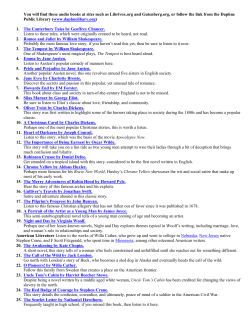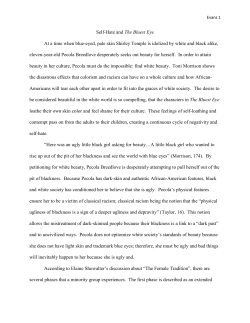
The Ugly Duckling H About the Tale
The Ugly Duckling About the Tale Level G H ans Christian Andersen was born in the small Danish town of Word Count Odense, in 1805. Like the ugly duckling, he was awkward and special. With nothing to sustain him but sheer determination, Hans 287 headed for Copenhagen. There, he went to college and later wrote an assortment of plays, novels, articles, and his beloved children’s tales. He penned “The Ugly Duckling” in 1844. This lovely story of a homely bird that “blooms” into a gorgeous swan has been translated into dozens of Vocabulary curious, geese, heron, pecked Supportive Features repetitive, patterned text; short sentences languages—English among them. It remains one of Anderson’s most celebrated works. Challenging Features use of interior commas dialogue, moral of tale Discussion Questions 1. Why do the other birds make fun of the ugly duckling? 2. Why is the ugly duckling afraid to show his face to the swans? 3. At the end of the story, the ugly duckling decides “to be kind to all Comprehension Use this book with the Compare/Contrast Venn on page 25. living things, from peacocks to potato bugs.” Why? Phonics Notable Retellings final e: time, five, cute, while, came, face, spoke, made, lake B The Ugly Duckling by Hans Christian Anderson (Mineditions, 1995). This faithful translation of Anderson’s fluid tale is a bit melancholy, but oh-so beautiful. Writing B The Ugly Duckling by Lorinda Bryan Cawley (Voyager Books, 1979). Charming pictures and text combine for a lively read-aloud. B The Ugly Duckling by Jerry Pinkney (HarperCollins, 1999). Kids are sure to respond to the wonderful art of this Caldecott-Honor book. Companion Reproducible Focus Skills: Following Directions, Vocabulary Development, Writing Fluency Name ____ ____ ________ ________ My Anim al Tale Fill in the Distribute copies of the reproducible of page 74. Then invite each child to fill in the blanks to write their own customized Animal Tale inspired by “The Ugly Duckling.” blanks to write ________ your own ________ _______ tale. Have partners reread the story, taking turns to read one page at a time. Circulate and listen in. Model how to read the longer sentences, which contain phrases or clauses separated by commas. Guide • page 74 • Folk & Fairy Tale Easy Readers Teaching Once upo n a time , a little ________ ________ for a wal ______ wen k. He me animal t t some me an ____ ________ “You are ____ ugly! Go different anim______s. away.” al They said . Next, he met som e mean ________ ________ “You are different anim______s. ugly. Go away,” al they said . Finally, he met som e nice ____ ________ ____ “Don’t look different anim ______s. at me. I al am ugly ,” he said . “You are not ugly . You are just diffe rent. Let’ friends!” s be they said . Then, the y all wen t out for ________ ________ ice cream ______ flavor of ice and live cream d happily ever afte r! THE END Scholastic 74 Have children draw a picture of the ugly duckling after it has grown into a beautiful swan. Around the picture, ask children to write words to describe the swan, such as white and feathery. 73 Folk & Fairy Tale Easy Readers Teaching Guide © Scholastic Teaching Resources Name _______________________________________________ My Animal Tale Fill in the blanks to write your own tale. Once upon a time, a little ______________________ went animal for a walk. He met some mean ______________________s. different animal “You are ugly! Go away.” They said. Next, he met some mean ______________________s. different animal “You are ugly. Go away,” they said. Finally, he met some nice ______________________s. different animal “Don’t look at me. I am ugly,” he said. “You are not ugly. You are just different. Let’s be friends!” they said. Then, they all went out for ______________________ flavor of ice cream ice cream and lived happily ever after! 74 THE END Folk & Fairy Tale Easy Readers Teaching Guide © Scholastic Teaching Resources
© Copyright 2025














